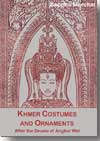| Our Publications | ||
| Books by Title | ||
| Books by Author | ||
| Books by Country | ||
| E-books | ||
| About | ||
| Orchid Press E-books | ||
| Distributed E-books | ||
| Our Bookshop | ||
| About Us | ||
| Browse Shop | ||
| How to Buy | ||
| Contact Us | ||
| WE BUY BOOKS AND LIBRARIES | ||
|
||
Book Reviews

Khmer Costumes and Ornaments:
After the Devata of Angkor Wat
bySappho Marchal
(translated from the French by Merrily Hansen)First English edition Orchid Press 2005. (1st French edition, 1927) 128 pp., 44 b & w pl., including numerous line drawings, 21.5 x 15.2 cm., softcover.
ISBN-10: 974-524-057-5 $16.00
ISBN-13: 978-974-524-057-5
A View from the Ruins
A detailed study of the apasaras’ clothes and hairstyles from a woman who was virtually raised within Angkor many decades ago
Book Review by Michael Smithies
(The Nation, Sunday 10 July 2007)
This book first appeared in 1927 in French, and is here ably translated by Merrily Hansen, who took a liking to the Khmer carvings and bas-reliefs in Angkor a few years back, and was entranced by the proliferation of devatas.
One likes them or one does not. Pierre Loti wrote in 1912: ‘How pretty and smiling they are, in their coiffures of goddesses, with nevertheless always that expression of mysteriously hinting at something which is so disturbing. Richly adorned… in their niches embroidered with carving, they remain adorable.’
Snellgrove was unmoved in 2004: ‘The celestial maidens [apasaras], all looking so much the same, whom one meets at every corner, do little to gladden the heart.’
The author of this slim volume, Sappho Marchal, was only 23 when her book was published. She was the daughter of Henri Marchal, the great curator of the EFEO in Angkor, and literally grew up among the ruins. She carefully observed all 1,737 devatas found at Angkor Wat (not including those on the towers) and categorised them into five types: ‘coiffures of hanging hair without a chignon; coiffures with a single chignon or a lock; coiffures with two chignons or two locks; coiffiires in the form of a small bonnet; and mukata , that is, apasaras wearing crowns like modem dancers’.
She then illustrates these in 41 plates, with sometimes 16 or more examples in each, grouping objects as far as possible, and providing detailed notes for headdresses, jewelled ornaments and the objects carried, most often a stylised lotus flower.
She goes into great detail about the sarong worn by the apasaras, even detailing how it must have been cut to be worn in the fashion shown.
But here one has to pause for thought: these are, after all, heavenly maidens, minor deities. There is no reason to think that they bore exact resemblance to court ladies of the Angkor period; indeed, there is every reason to think the opposite.
They were idealised. Therefore their panels of flowing cloth are not really likely to be true representations, but figments of artistic imagination, probably reinforced somewhere by texts of Indian origin.
Loti quotes a text of Valmiki: ‘From the swirling waters arose the Apasaras, celestial dancers and courtesans, who were of incomparable beauty. They became the wives of the demigods, the Gandharwas.’
Certainly some of the materials used for the sarong were transparent, but the details reveal no commonly found weaving designs, and it seems rather unlikely that even court Khmer would cut lengths of fine, divine cloth in such a wasteful fashion as shown here.
This seems all the more so as Zhou Daguan, writing in 1296-7, tells us that the seamstresses in Angkor were all Thai: ‘The Siamese women know bow to sew and dam. When a length of cloth which [the Khmer] want to wear is torn, the natives employ [Siamese women] to repair it.’ Repair, please note, not cut nor hem.
The same goes for the weird and wonderful coiffures, with locks wound up to impossible Carmen Miranda heights.
With the crowns, one is on more familiar ground; the use of springs to provide a shimmering effect is common today, in Bali too.
But again the headdresses illustrated here are so high that all dance movements could only be slow, otherwise there would be a serious risk of the crown falling off.
Not surprising therefore that one member of the Covent Garden ballet dismissed Khmer classical dancing as ‘bloody boring’ some years back. It has to be noted, though, that the peasant tradition is to the fore in Bali, and the pace of dance movements much quicker than the court-inspired presentations elsewhere in Southeast Asia.
Marchal confined her study to the devatas at Angkor Wat, not including the towers, as well she might, for otherwise the task to enumerate, classify and draw them would have become well-nigh impossible.
The translator in an introductory note tells us that the total is now 1,860, this time including the towers, though many have been lost, from weather, the chemical effects of bat droppings, and looting.
It is useful to have this small book in print again, and in English, and it will no doubt find its way into the bags of many returning tourists.
[Read a review from www.devata.org] [Read a review from the Journal of the Siam Society] [Read a review from Cambodia Book Reviews] [Read a review from Amazon.com] [More Orchid Press Reviews]
PO Box 70, Trinity TB, NL, A0C 2S0, Canada
Telephone: +1 709-330-4703